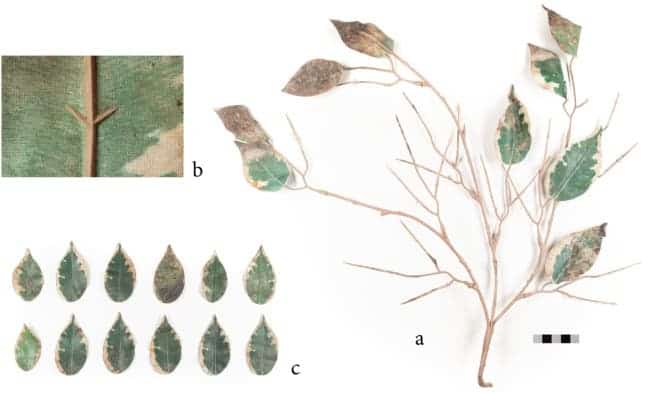“I think it’s almost like a joke,” Auke-Florian Hiemstra tells me.
We’re standing in a 12th-century church at a https://www.esof.eu/”>science meeting, and that’s not even the weirdest thing about it. The weirdest thing is Hiemstra’s study.
“Every time I look at it, it blows my mind. It’s so strange. They’re still using plants, but plastic fake ones. I think it’s such a weird mix of natural and artificial.”
Hiemstra’s PhD project is on animal architecture. He studies the structures made by animals (oftentimes, birds), and how man-made materials affect these structures. Two years ago, the biologist was surprised to read that man-made objects now exceed https://www.nature.com/articles/s41586-020-3010-5″>all living biomass in the world. It got him thinking.
From his own observations, when he would go with other researchers and volunteers to clean the picturesque canals of plastic and other garbage, he knew that plastic pollution can be a problem. In fact, this problem has been documented widely. Birds from https://theconversation.com/plastic-found-lining-uk-seabird-nests-on-a-worrying-scale-142118″>Europe to the https://www.nhm.ac.uk/discover/news/2018/october/seabirds-in-the-pacific-are-using-plastic-to-build-nests.html#:~:text=As%20brown%20boobies%20incorporate%20materials,plastic%20pollution%20in%20the%20tropics.”>Pacific have been found to use plastic for their nests, although assessing the scale of the problem seems different. But what Hiemstra found when he was conducting “nest dissections” was surprising: every now and again, he would come across artificial, plastic plants that looked just like the real thing.
“When I get it a nest and take it apart, the bird’s already done with the nest and it has been in the freezer to get rid of parasites. So while taking it apart, there were a few parts sticking out which were so green, so intensely green while everything else was withered and brown — and so these were the artificial plants,” Hiemstra notes.
The strange thing, however, was that while it’s not uncommon to find plastic in the waterways, finding plastic plants is pretty uncommon. In fact, the biologist is rarely able to find plastic plants, but the coots — a type of bird on which the study focused — are able to find them, even though they only gather material for nests from nearby.
“I’m not really sure where they come from. We don’t find artificial plants that often but strangely enough, the coots do find them and use them for their nests.”

Realistic plastic plants
A nest says a lot about a bird and its environment. Coots, for instance, which have adapted to many urban environments, can use all sorts of trash for their nests. In 2020, Hiemstra and colleagues published https://brill.com/view/journals/beh/159/2/article-p193_5.xml”>a report on the first population of freshwater birds studied for its use of anthropogenic nest materials.
They analyzed 12 coot nests they found in Leiden and found that all of them contained plastic. Almost a third of the nest material consisted of artificial materials, with the most common items being food packaging, cigarette packs, and straws. But some also contained artificial plants.
It’s not clear if the coots find these materials randomly or if they have some preference for them. It’s also unclear if the birds confuse plastic plants for the real thing.

Artificial plants are not necessarily a new thing. Ancient Egyptians would create plants from animal horns that they would paint, while the Romans made flowers from wax, silver, and even gold. Later on, silk flowers became more common, and in the 20th century, cellulose became the preferred material for a time — but silk is fragile and cellulose can create dangerous fires, so these quickly faded out of favor when plastic came in.
Plastic opened up a whole new world for artificial plant-makers. Suddenly, you could make durable, realistic, and cheap flowers. It was perfect; too perfect, almost. After a few decades in which people wanted plants to look as beautiful as possible, demand started to tweak. Real flowers don’t often look perfect, and a perfect-looking plastic plant stands out as obviously artificial. Sellers have also adapted and are selling increasingly realistic plants.
“Nowadays, people actually don’t want the plastic fake plan to be too perfect because if it’s too perfect, everyone sees this plant as artificial and you don’t want that. So actually, nowadays there are even websites selling slightly browning fake plants.”

For instance, the fake Ficus plant shown above used as nesting material by some coots was described by its manufacturer as “indistinguishable from the real thing”. IKEA referred to their fake Dianthus as “so real that you can almost smell them”. Sure, there’s a good degree of marketing in those claims, but the resemblance to reality has become an important selling point for sellers — and realistic plants are just as likely to end up as litter.
The diversity of available plastic ‘species’ has broadened as demand for realistic, varied plants increased. This makes artificial items virtually indistinguishable from the real things and makes it increasingly likely for birds to be tricked and simply use plastic plants, especially when other materials are scarce. As plastic plants imitate the natural world, they are probably more likely to make their way into bird nests.
But the birds could also be selecting plastic for different reasons.
Plastic is… not fantastic, but can be helpful
You’d expect plastic to have a negative effect (and this is very possible), and it can definitely cause problems. Birds can ingest the plastic or get tangled into it, and plastic may https://www.zmescience.com/medicine/microplastics-help-viruses-02072022/”>harbor infectious agents, but but plastic could also offer some advantages.
For starters, it may be easier to find, thereby reducing search costs for nesting material and https://www.academia.edu/19616912/A_new_material_for_old_solutions_the_case_of_plastic_string_used_in_Great_Grey_Shrike_nests”>resulting in an increased building speed. It may also be more attractive when it comes to https://link.springer.com/article/10.1007/s00265-003-0583-6#:~:text=Males%20displaying%20higher%20numbers%20of,the%20bower%20(Borgia%201985).”>finding a mate. Most significantly, perhaps, it could help build more durable nests.
“Sometimes we find these plastic bands — the record is nine meters — and they go around the nest three or four times which makes the nest really strong. Just using this plastic, circling the next, it made it extremely strong.
We’re also looking into the effects of heat regulation on the nest. This plastic may keep the nest warmer, for instance. So there could also be a lot of benefits.”
An Anthropocene problem
Plastic flowers are just a small part of Hiemstra’s study — and they’re just a small part of our plastic problem. The world https://ourworldindata.org/plastic-pollution”>produces some 381 million tons of plastic a year, and we waste just as much (or more, because we also waste stuff that’s been produced in previous years). Under 20% of this plastic is recycled, and about a quarter is incinerated. More than half of it is discarded, with much of it reaching the world’s water.
For seabirds, it’s an absolute ecological disaster. Some https://www.nationalgeographic.com/science/article/15092-plastic-seabirds-albatross-australia”>90% of seabirds are consuming plastic, with devastating https://www.wwf.org.au/news/blogs/how-many-birds-die-from-plastic-pollution”>consequences on their health. But even closer to us, in our very cities, there’s a lot of plastic pollution, and we don’t truly understand the impact this plastic has on birds.
In the grand scheme of things, plastic plants don’t really matter; there’s too much other plastic around them. But it’s an interesting metaphor, a reminder of how the artificial materials we’re building are slowly replacing the natural world. It’s also an opportunity to raise awareness of these problems.
“The plastic plants we encountered in the birds’ nests are now part of the Dutch National Herbarium, they’re stored like they have real scientific names. The first plastic artificial plants in a national collection of more than 5 million plans. It was all real, but the first artificial are now added to the collection,” Hiemstra says.
The researcher is also working with people from the Netherlands to get a more bird’s-eye view of the situation. Last year, they carried out a big citizen science project on coots where more than 4,000 people participated. Hiemstra also works in projects on improving cleanup efforts and limiting the amount of plastic that ends up in the waterways.
Ultimately, there’s also a distinct irony to how these birds are using plastic. Oftentimes, they use a piece of plastic that humans consider single-use for weeks or months on end.
“It’s crazy. It can last for hundreds of years. So it’s so stupid that we use it as a single-use material. These birds use it for four weeks or four months.”
“So I think that’s something that we can learn from these birds. If you use plastic, use it for as long as possible, because it’s made to last.”
https://www.zmescience.com/other/pieces/birds-plastic-nest-12082022/”>
